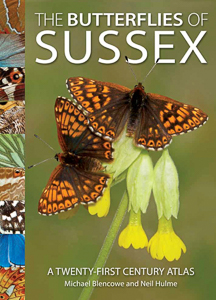 |
by Michael Blencowe and Neil Hulme
Published by Pisces Publications, May 2017
Hardback, 326 pages. ISBN: 978-1-874357-77-3
From the publisher: Sussex, sitting on the South Coast and boasting a diverse range of habitats set within beautiful, iconic landscapes, has always been recognised as one of the best areas of the country in which to watch and appreciate our butterflies. This work summarises their current distribution and status, based on an intensive five year survey by local Butterfly Conservation members. The lavishly illustrated texts, covering 53 species, include many original insights into a rapidly changing world of losses and gains, capturing an unprecedented period in the history of British butterflies. While some species have declined as the result of habitat loss and climate change, others have been brought back from the very brink by targeted conservation efforts. Meanwhile, exotic butterflies such as the Long-tailed Blue and Continental Swallowtail now regularly migrate into Sussex from mainland Europe. The book also features a comprehensive guide to the county's best butterfly sites, covering the sandy lowland heaths, rolling chalk hills of the South Downs and tranquil woods of the Weald. Authors Neil Hulme and Michael Blencowe are Sussex naturalists whose conservation work and writing are well known. The foreword is provided by the indomitable butterfly enthusiast Matthew Oates, who longs to return to the county of his school years. This is an essential book for any butterfly lover, from beginner to expert.
When I first heard about the 5-year project to create a Sussex butterfly atlas I thought, to put it simply, that it would be a useful contribution to our collective knowledge. What I didn't expect is this book - which is so much more. If you think you'll be served up a pretty dry tome containing basic information on species, sites, distribution and population trends, then you could not be more wrong.
The first thing to hit you, aside from the beautiful photo of male and female Duke of Burgundy on the cover by Neil Hulme (an accomplished photographer whose images make up the majority) is the size of this 326-page and beautifully-produced hardback - it is almost certainly the most extensive county atlas I have. Flicking through the book from front to back, pausing to read the content on a smattering of pages, tells you that this is a book of substance and is going to be mentioned in the same breath as the "gold standard" in butterfly books, The Butterflies of Britain and Ireland by Jeremy Thomas and Richard Lewington.
The book's foreword is written by the well-known naturalist Matthew Oates in his inimitable style and author of the excellent In Pursuit of Butterflies - a fifty-year affair. He pretty much sums up my own view of the atlas in three succinct sentences: "... the ecological information and thinking in [the book] has relevance way beyond the boundaries of Sussex. It contains profound insight into the ecology and conservation needs of most of Britain's butterflies. Without doubt, this is the most enlightening of the many county butterfly books available".
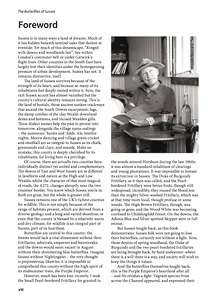 | 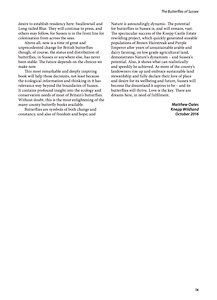 |
The authors have "divided and conquered" by divvying up the writing, with Neil Hulme writing the species accounts (which is no mean feat given the species coverage, more on these accounts below) and Michael Blencowe all other chapters. I mention this because anyone who has been Blencowe'd will know that they're in for a treat; the humour that Michael brings to his presentations translates perfectly to the written word. I could provide an example, but I don't want to spoil your fun. The chapters on the "National Character Areas" of Sussex, weather during the survey period and butterfly recording in Sussex have Blencowe stamped all over them.
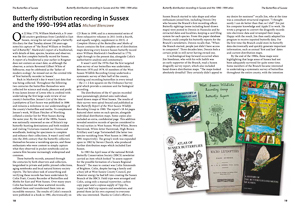 |
The species accounts are a tour de force and expertly-written. What I mean by this is that Neil has not only done his research (quoting relevant historical as well as contemporary sources, where appropriate), but has also added his own thoughts throughout, such as why the female Duke of Burgundy has six fully-functional legs and the male only four, and why the Small Tortoiseshell, a once-common butterfly, has declined. The accounts also include various tips regarding both ID and photography and this lavishly-produced book with its superb imagery will appeal to any butterfly photographer.
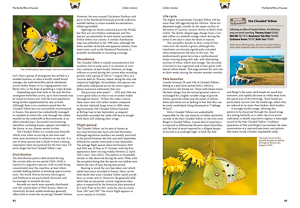 | 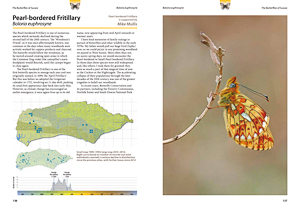 |
Of course, this is an atlas of Sussex, which is all-too-easy to forget, and therefore certain elements, such as distribution trends, abundance trends, where to see the butterfly and flight periods are all Sussex-focused. However, the remainder of the species accounts is more general and therefore relevant to any area of the British Isles. This also applies to some of the more-surprising species accounts, such as those of the continental Swallowtail, Scarce Tortoiseshell and Long-tailed Blue; Sussex is definitely blessed when it comes to our changing fauna, since it is one of the first counties to feel the effect of migrant species. The book also includes species accounts of Glanville Fritillary, Geranium Bronze and Monarch on the basis of a single sighting in each case during the study period, although the historical backdrop of these species in Sussex makes for an interesting read. The book concludes with summaries of 60 sites to visit in Sussex, and the species found there.
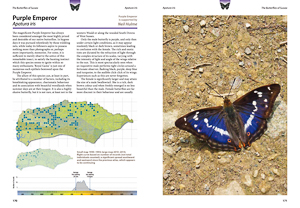 | 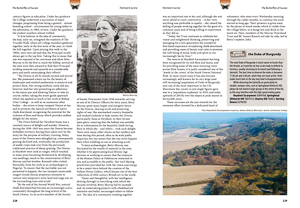 |
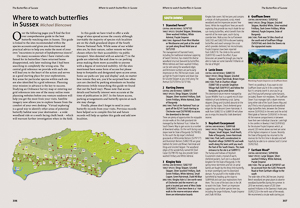 |
Overall, the book is extremely well written. What I mean by this is that the book "flows" - I'm not sure how else to describe it - it is simply a delight to read. It was also good to see homage paid to those that have made this book possible - the many recorders and volunteers that the Sussex branch of Butterfly Conservation seem so adept at mobilising.
Over the years I've reviewed many books and there are a few (and I mean, only a few) that no review could do justice to. I'm afraid that this is one of them, and so you'll just need to get the book to see what I mean - you won't be disappointed.
The two authors have each made a significant contribution to fostering an interest in Lepidoptera (and especially butterflies) not only in their part of the world, but across the British Isles and beyond - something I have always admired. I suspect that this book will bring them many more admirers, and rightly so. I cannot recommend the book highly enough and it should be considered essential reading for anyone who loves butterflies.
The book can be found in all good book stores (and those online) and can be ordered direct from the publisher.